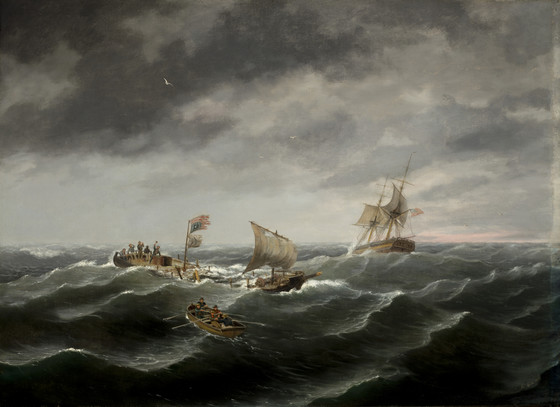Although he achieved success with his ship portraits, Birch’s distinctive contribution to American art was his more romantic renderings of ships in storms, such as Loss of the Schooner "John S....
Although he achieved success with his ship portraits, Birch’s distinctive contribution to American art was his more romantic renderings of ships in storms, such as Loss of the Schooner "John S. Spence" . . . . In his cool palette, evocative sky, and turbulent sea Birch reveals the influence of Joseph Vernet (1714-1789), a French marine painter whose imaginative works were available to the artist in Philadelphia. Although Birch was actually depicting the aftermath of the storm, he still conveyed its power through the vigorous waves, overcast sky, brisk wind, and the narrative element of the destroyed ship.
Although some of Birch’s stormy marines were fictional, at least two, the museum’s painting and The Loss of the New York Packet Ship "Albion," exhibited 1824 (unlocated), were based on actual events. The schooner "John S. Spence" was lost at sea not long after it had left the port of Norfolk, Virginia, bound for Havana, Cuba. The museum’s painting was commissioned by Alexander M. Peltz, one of the passengers on the schooner during its last voyage. At the age of nineteen Peltz, desirous adventure, left his home in Washington, D.C., and on August 19, 1827, set sail from Norfolk, Virginia, on the "Spence" in the company of a childhood friend, intending to travel to Mexico to join the company of the former US commodore David Porter. Six days later the schooner was wrecked in a storm on the open sea, its bowsprit and taffrail broken, and its masts transformed into a confusion of ropes and broken wood. Five survivors, including Pelz-but not his friend-were rescued a week after the wreck by a New England captain, Isaac Staples of the brig "Cobosse Contee," but only three lived to reach New York.
Peltz originally intended to give the painting to Captain Staples, his rescuer. Staples was lost at sea before the painting was completed, however, so it remained in Peltz’s family until 1982. Shortly before his death Peltz wrote an account of the voyage, disaster, and struggle to survive without food and water. Birch no doubt based much of his rendering on Peltz’s oral account, for the written account demonstrates that he vividly recalled the details of the disaster.
When the painting was exhibited in 1834 at the Pennsylvania Academy of the Fine Arts it was listed as a "second view." Birch used the incident as the basis for an engraving that appeared in the 1836 volume of The Token; however, this drawn The Wreck at Sea is a close-up view from on board the "Spence" rather than from the distant perspective, and it depicts only four men being rescued.
More...



